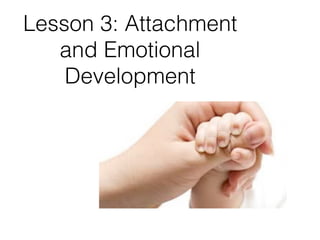Lesson 3 attachment and emotional development
•
1 j'aime•2,228 vues
Attachment and emotional development
Signaler
Partager
Signaler
Partager
Télécharger pour lire hors ligne

Contenu connexe
Tendances (20)
En vedette
En vedette (20)
Lesson 5 the role of the neuron in memory formation 2012 sh

Lesson 5 the role of the neuron in memory formation 2012 sh
Similaire à Lesson 3 attachment and emotional development
Similaire à Lesson 3 attachment and emotional development (14)
Attachment Programs and Families Working Together Learn.docx

Attachment Programs and Families Working Together Learn.docx
B.Ed notes Course 1 attachment and bonding namrata

B.Ed notes Course 1 attachment and bonding namrata
Plus de coburgpsych
Plus de coburgpsych (20)
Lesson 1 physiological and psychological charactertistics of responses to s...

Lesson 1 physiological and psychological charactertistics of responses to s...
Dernier
Making communications land - Are they received and understood as intended? we...

Making communications land - Are they received and understood as intended? we...Association for Project Management
Mehran University Newsletter Vol-X, Issue-I, 2024

Mehran University Newsletter Vol-X, Issue-I, 2024Mehran University of Engineering & Technology, Jamshoro
Dernier (20)
Food safety_Challenges food safety laboratories_.pdf

Food safety_Challenges food safety laboratories_.pdf
Salient Features of India constitution especially power and functions

Salient Features of India constitution especially power and functions
HMCS Max Bernays Pre-Deployment Brief (May 2024).pptx

HMCS Max Bernays Pre-Deployment Brief (May 2024).pptx
UGC NET Paper 1 Mathematical Reasoning & Aptitude.pdf

UGC NET Paper 1 Mathematical Reasoning & Aptitude.pdf
Unit 3 Emotional Intelligence and Spiritual Intelligence.pdf

Unit 3 Emotional Intelligence and Spiritual Intelligence.pdf
Kodo Millet PPT made by Ghanshyam bairwa college of Agriculture kumher bhara...

Kodo Millet PPT made by Ghanshyam bairwa college of Agriculture kumher bhara...
Making communications land - Are they received and understood as intended? we...

Making communications land - Are they received and understood as intended? we...
ICT Role in 21st Century Education & its Challenges.pptx

ICT Role in 21st Century Education & its Challenges.pptx
Lesson 3 attachment and emotional development
- 1. Lesson 3: Attachment and Emotional Development
- 2. Attachment is a relationship between two people in which each person feels strongly about the other. In infancy, attachment refers to the emotional bond which forms between an infant and another person.
- 3. Ainsworth and the Strange Situation
- 5. Factors influencing attachment Genetics Bowlby (1969) argued that all infants have an inborn, ‘primary drive’ to form an attachment with a caregiver. He considered the infant–caregiver bond to be important in two ways. The bond has an ‘evolutionary’ function, which, according to Bowlby, improves the infant’s chances of survival. The bond forms the foundation for healthy emotional development later in life.
- 6. Temperament Temperament is defined as our characteristic way of reacting to people, objects and events Infants can have three types of temperaments •easy •difficult •slow-to-warm up A number of researches have argued that temperament influences attachment by influencing the caregiver’s attitude to an infant.
- 7. Early life experience A secure attachment is most likely to be formed with the person(s) who is most sensitive to these signals and responds appropriately. Ainsworth (1983) referred to this factor as the sensitive responsiveness of the caregiver and believes that it is crucial in the type of attachment formed between an infant and caregiver. Infants can’t recognise words until about 12 months. Up until that time they use body language such as smiling, gazing, reaching, squirming and clinging, and vocalisations such as crying and babbling What factors would influence the level of ‘Sensitive responsiveness?
- 8. Harlow’s experiments on attachment in monkeys